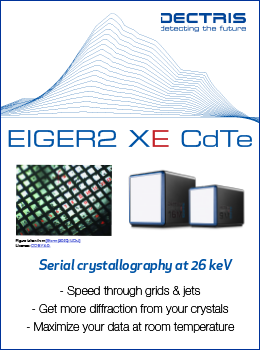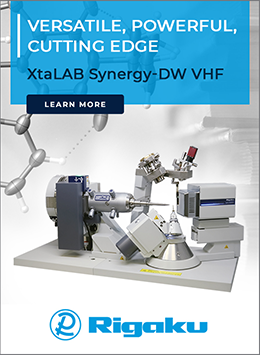


Editorial
Editorial
![Thumbnail [Thumbnail]](https://www.iucr.org/__data/assets/image/0006/148623/hexamethyl.gif)
I guess that as I write, most of us are still under lockdown or at least being very careful to avoid exposure from the SARS CoV-2 virus. The COVID crisis continues without an end in sight; maybe a search for a vaccine or a treatment, at least, will be found. But we can expect to be living with this virus for a very long time. It is important, however, to note that if a vaccine is to be developed it will be largely thanks to the efforts of many crystallographers working in macromolecular studies around the world, for it is our subject that helps to elucidate the structure of SARS-CoV-2 and its various associated proteins and enzymes. To illustrate the importance of crystallography in this field, we are publishing in this issue of the IUCr Newsletter a series of excellent articles on developments in the coronavirus research using advanced sources, thanks to our editors Tiffany L. Kinnibrugh and Abel Moreno.
On another topic, suppose I ask you: who discovered X-rays? Of course, you will be shouting ROENTGEN 1895! However, I have seen over many years that great discoveries are often not quite as they seem and are not necessarily the work of a single individual. Generally, there are other persons involved, some even making earlier discoveries, persons who are largely forgotten or ignored. The story of Roentgen’s accidental discovery is well documented and widely known. However, one must ask what is meant by “discovery”? Is it a well defined or a fuzzy notion?
Roentgen's discovery of X-rays crowned research into cathode rays in which many people had been involved and contributed. Some of them were hot on the track, some were less successful or wrong in their ideas, but not only successful experiments can inspire a discovery.
A good example of the difficulty in pinning down who did what is offered by the career and work of a Ukrainian-born electrical engineer, Ivan (Johann) Puluj, and we publish here a study of his life and works, written especially for us by an historian of science, Emilie Těšínská. It is clear that some 15 years before Roentgen’s work, Puluj had been researching cathode ray tubes and had invented his so-called Puluj lamp, in which an inserted screen coated with calcium sulfide glowed brightly. Some references on the internet even suggest that he had given one of his lamps to Roentgen. So, it is very likely that Puluj had been producing X-rays earlier but probably failed to realise the existence of these mysterious rays. Certainly, within months after Roentgen’s announcement in 1895, Puluj was using his apparatus to take X-ray images of whole bodies of dead animals, and bone structures of superb quality, even exceeding those of Roentgen. Here Puluj surely profited from his deep knowledge and his practical work in electrical engineering. So, what do you think? Who “discovered” X-rays?
The IUCr has been in existence now for around 73 years, serving the crystallography community through its many journals and other publications, by providing grants, sponsoring students and lecturers, visiting professors, activity in Africa, and many, many more activities. Of course, you will be aware of the high quality of our journals. These are supported by highly dedicated staff at our Chester (UK) office, for whom we are always grateful. However, all this costs money, and no more importantly now given the global financial crisis that we are certainly about to suffer. In this issue of the Newsletter, the Convenor of the Finance Committee, Malcolm Cooper, explains the ins and outs of this critical IUCr Committee. Wrong decisions by this Committee could have profound implications for the prospects of the IUCr.
As an example of the international nature of crystallography, Elena Boldyreva and colleagues report on a successful scientific student conference held in April of this year at the Novosibirsk State University. This is the kind of conference – online, global and interdisciplinary – that is now becoming commonplace. It is wonderful that the development of software tools such as Zoom, or Teams is enabling students and scientists to get together while sitting in their own homes. As another example, recently, I was asked by Sandro Scandolo at the ICTP (International Centre for Theoretical Physics, Trieste) to give a virtual plenary lecture entitled “Why Crystallography?” as part of an online course called Solid State Physics in Quarantine. It was an odd feeling to be sitting at home and talking to an audience of several hundreds around different parts of the world.
Sometimes it is worth recalling just how difficult it used to be to work in crystallography, especially as these days we have such fantastic automatic, computer-controlled systems. Jon Cooper describes one of the first commercial diffractometers in the UK. This so-called linear diffractometer was used to elucidate the structure of lysozyme, the first enzyme structure to be determined. So, the linear diffractometer was a significant advance, although I remember that it was a fearful beast that was difficult to use. It is worth recalling that after W. H. Bragg built his ionisation spectrometer, the forerunner to the modern diffractometer, almost all X-ray diffraction was carried out using film techniques. I recall how, by using film methods, we had to become proficient in orienting crystals and finding our way in reciprocal space: crystallographers today are spared from having to do this.
Following on from this, the fantastic efficiencies of modern diffractometers have meant that huge numbers of crystal structures are being determined, and many are not published. The whole question of publishing this material is raised by Bill Clegg here. It is a tricky problem to solve. Bill asks controversial questions: Why publish? Why not publish?
Finally, in the last Newsletter we published a list of Biographical Memoirs of the Royal Society where you can read the life histories of many famous scientists with a crystallographic connection. Recently, the Royal Society has added one on J. F. Nye. He worked in many areas of science, including studies of ice and of dislocations in crystals. Many of you will be familiar with his classic textbook Physical Properties of Crystals.
Stay safe!
Copyright © - All Rights Reserved - International Union of Crystallography








